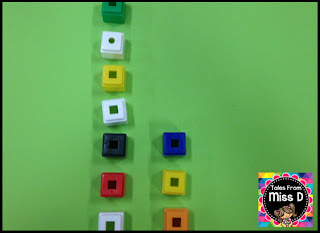Looking through the syllabus, the team all agreed that we needed more work on the strand; comparing numbers to determine 'how many more'
As a team, we decided on the best way to teach this concept and that this would be the modelled part of our guided maths session.
#1 - Get two groups of objects (can be counters, unfix cubes, etc).
#2 - Line up objects side by side, making sure the objects match/have a partner.
#3 - Look at where the matches stop and separate the objects that don't have a partner.
#4 - The objects that don't have a partner tell us 'how many more' are in the group.
When introducing the concept, stick to examples that don't have a huge difference i.e do 7 and 4 not 5 and 20. Keep it simple with small differences. Work on larger differences in the guided group part.
Of course, I want my students to be applying this independently while I am working with my small groups, so I made two centers that work on developing this skill.
Activity #1
In this activity, students pick a card and place that many counters/cubes on the top row. They pick another card and place that many counters/cubes on the bottom row. They then look at where the matching stops to determine 'how many more' and write the number at the bottom.
The grid is a great way for students to make sure the objects are lined up properly. If the objects are not lined up, then this strategy falls apart.
Activity #2
In this activity, students pick a card and make towers that correspond with the numbers. To find out how many more, students break the tower so that they become even. The amount broken off will reveal 'how many more'.
Students can then write the answer on the line.
Very simple, yet effective activities for students to develop this skill. You can find this product by clicking on the picture below :)
Enjoy the rest of your week!








No comments:
Post a Comment